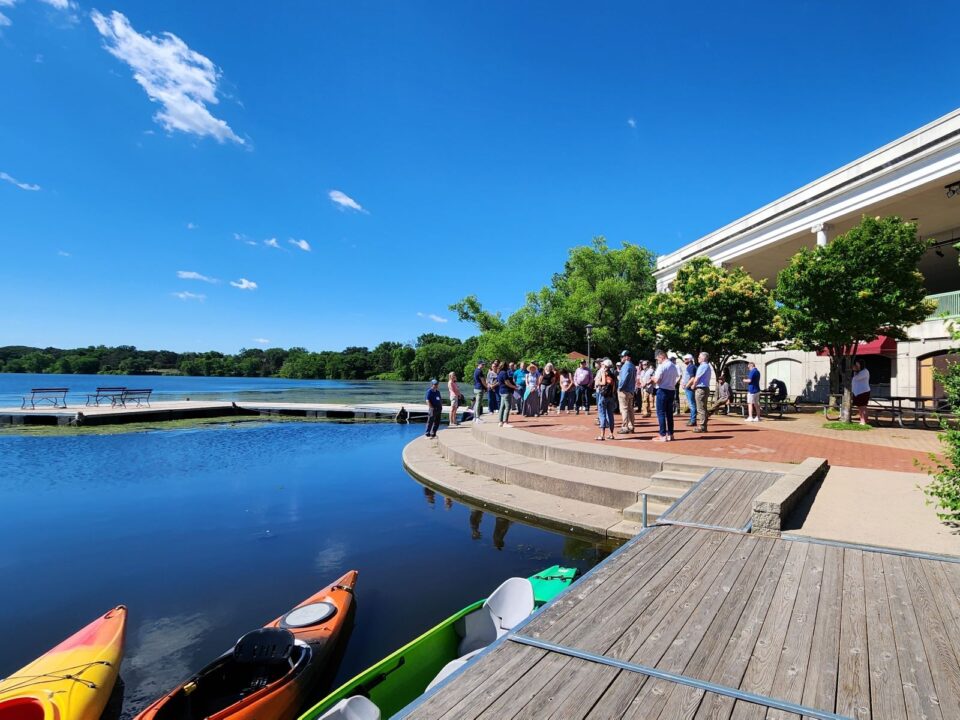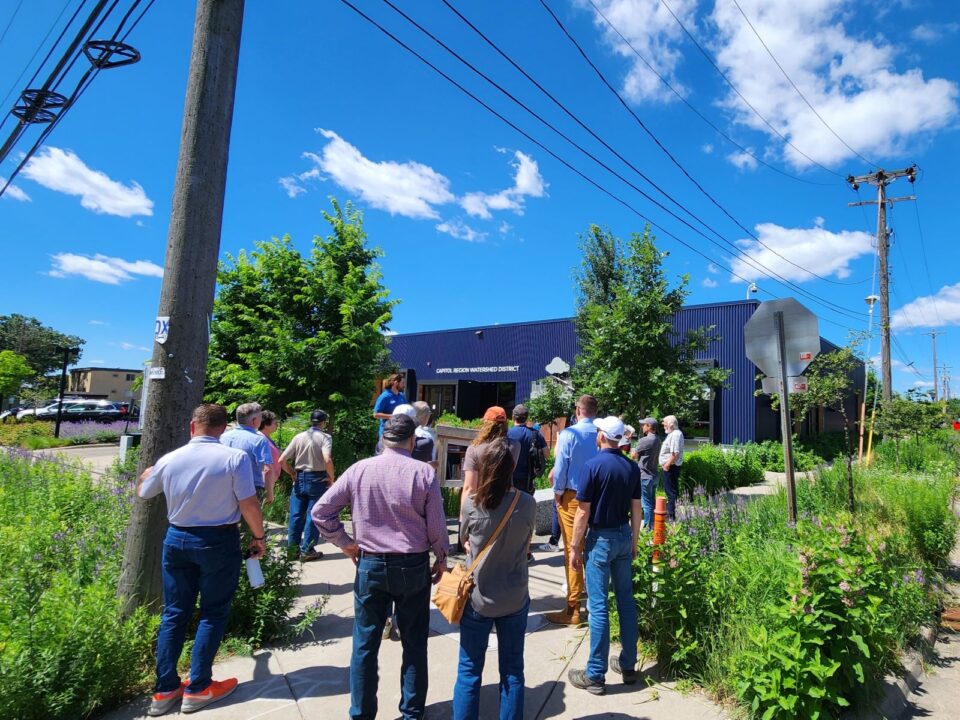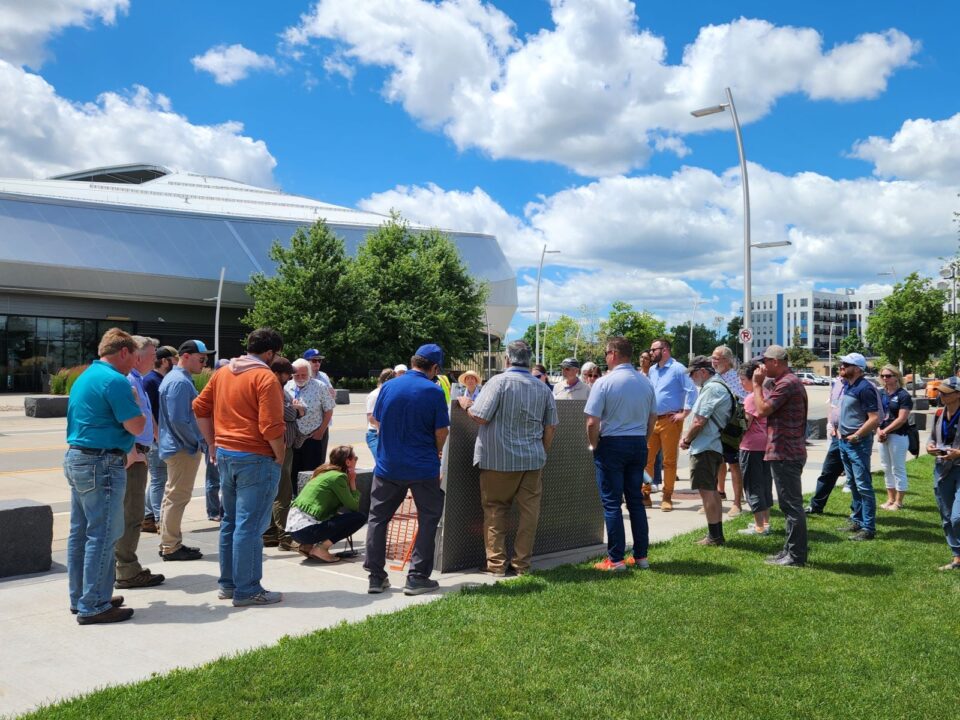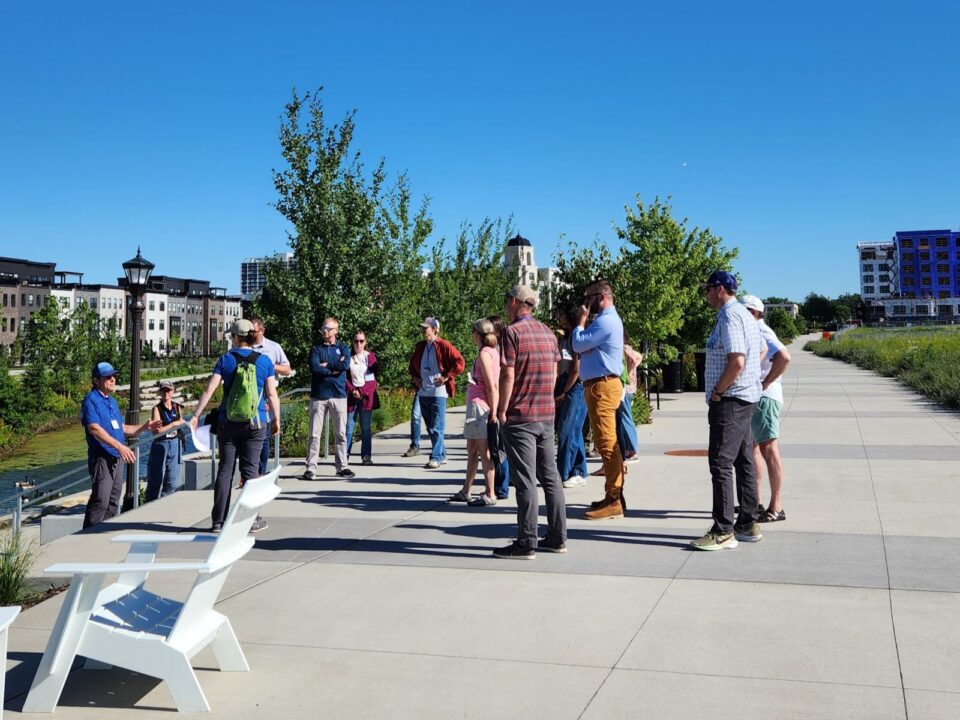MN Watersheds Summer Tour
Capitol Region Watershed District (CRWD) and our neighboring Ramsey Washington Metro Watershed District (RWMWD) co-hosted the annual Minnesota Watersheds Summer Tour this year. On Wednesday, June 26, 2024, a perfect Minnesota summer day, over 100 people from across the state toured key sites in CRWD and RWMWD. CRWD led tours at Como Lake, our office Watershed Learning Center, Allianz Field, and Highland Bridge.
Minnesota Watersheds (formerly Minnesota Association of Watershed Districts) is a non-profit, membership-based organization serving Minnesota’s watershed-focused local governments. The summer tour’s attendees included administrators, staff, and Board managers from across the state.
Como Lake
At Como Lake, tourgoers heard recent lake news from Monitoring & Research Division Manager Britta Belden and Sarah Wein, Water Resource Project Manager with our Monitoring & Research Division. Britta and Sarah shared that the lake recently had the best water quality observed in over forty years and the lowest average annual total phosphorus value!
The tour attendees looked out over the 70-acre urban lake that drains more than 1,711 acres of land in Saint Paul, Roseville, and Falcon Heights as Britta highlighted how CRWD and partners have been working to improve Como’s water quality for 25 years through many plans, projects and programs.
- The 2019 adaptive Como Lake Management Plan builds on previous work with a specific focus on management within the lake. It is updated every few years as short-term actions are implemented and evaluated.
- The District’s monitoring program collects valuable information about Como Lake and the stormwater from the surrounding watershed. The data helps us understand how the lake is doing, how well stormwater improvements are performing, and other factors affecting the lake.
- Como Watershed BMPs include the Arlington-Pascal Stormwater Improvement Project with raingardens, infiltration trenches, underground infiltration and stormwater ponds; underground infiltration at Como Park High School; Como Golf Course BMPs with an infiltration system and a pond with an iron-enhanced sand filter; and Boulevard Rain Gardens at residential properties throughout the neighborhood.
- In and near lake projects include the 2020 alum treatment, fishery management, ongoing lakeshore management, and aquatic plant management with curly-leaf pondweed control and reestablishment of the native aquatic plant community.
CRWD Watershed Learning Center
Communications and Engagement Division Manager Jessica Bromelkamp and Luke Martinkosky, Water Resources Regulatory Specialist with our Regulatory Division, spearheaded the visit to our building and grounds known as the Watershed Learning Center.. Jessica shared a video, Breathing New Life Into an Old Building, showing how CRWD rehabilitated a brownfield site and an 80-year-old building in the Hamline Midway neighborhood of Saint Paul into our LEED v4 Gold-certified Watershed Learning Center.
Jessica and Luke led tours featuring the building’s many sustainable details.
- The rainwater capture system, including a 3,000-gallon cistern in our lobby, collects water from the roof for reuse to flush toilets and in the pocket park.
- Smart building features like blinds that adjust automatically help maximize natural daylight and minimize electricity use for office lighting.
- Recycled materials, such as wooden panels from invasive Siberian Elm harvested at nearby Willow Reserve, clad our office walls, and carpeting made from recycled fishing nets from the Philippines provided colorful, modern office flooring.
- Solar power from panels on our garage roof supplies 20% of our electricity needs.
After heading outside, tourgoers strolled around the grounds with community green spaces and multiple stormwater BMPs like tree trenches, permeable pavers, rain gardens, and an underground infiltration system. They enjoyed the pocket park, which was lush with blooming native plants and a tranquil pond with a small burbling stream channel fed by rainwater from the cistern. Attendees enjoyed perusing our interactive Watershed exhibit and the Water Wildlife Exploration Game for the sidewalk stamps around our building. As the tour departed, a family from the neighborhood walked up to play in the pocket park.
Allianz Field
The site at Allianz Field was bustling with a career fair and prep for an upcoming stadium event as Facility Management Division Manager Forrest Kelley and Chris Kucek, Projects and Grants Specialist with our Planning, Projects and Grants Division, discussed the stormwater reuse system underground. CRWD worked with the City of Saint Paul, Minnesota United FC, and site owners RK Midway to include innovative shared, stacked green infrastructure (SSGI) at Allianz Field. Below an expanse of the neatly manicured Great Lawn, a centralized tank north of the soccer stadium holds 675,000 gallons of water from the soccer stadium’s roof. With a larger group, the tour stayed above ground, but they got to peek into the ‘vault’, a utility room below the sidewalk with the pump and filtration for the reuse system.
Currently, the stadium uses reclaimed water to irrigate the three-quarter-acre park north of the stadium, nearly 200 trees, and other green spaces on site. Upon the complete redevelopment of the 35-acre site and connections to the comprehensive rainwater capture and reuse system, upwards of 2 million gallons of water per year can be conserved. Future development and businesses around the stadium can use the reclaimed and filtered water for irrigation, laundry, and restrooms. The SSGI approach to the project will also help achieve greater density on the site, consistent with long-range plans for the community, making the Snelling Midway redevelopment the centerpiece of a revitalized urban neighborhood while protecting the Mississippi River.
Highland Bridge
It was a picture-perfect morning of fluffy clouds in a bright blue sky at Highland Bridge on the Mississippi River bluffs. Deputy Administrator Bob Fossum and Regulatory Division Manager Elizabeth Hosch guided tourgoers through the site’s many spectacular features. Treated stormwater fills the central water feature, flowing to the reimagined Hidden Falls Creek before emerging at the new Mississippi Boulevard Crossing, tumbling over its namesake falls, and ending at the Mississippi River. Paths, rain gardens, and inviting nature stretches surround the water features. The expansive vistas from the river bluffs enhance the entire area.
CRWD, the City of Saint Paul, and their partners began planning to redevelop the former Ford Assembly Plant in 2009. After over a decade of careful planning, the shared, stacked green infrastructure (SSGI) systems are complete. Highland Bridge now has a centralized, integrated stormwater management approach that eliminates the need for individual treatment systems scattered across the 122-acre site. The new shared stormwater systems at Highland Bridge capture and clean 64 million gallons of runoff annually, preventing an estimated 28 tons of total suspended solids and 147 pounds of phosphorus from entering the Mississippi River yearly. The reimagined Hidden Falls Creek and a connection to Hidden Falls Regional Park via a 90-foot tunnel underneath Mississippi River Boulevard with a paved pedestrian and bike path end at an overlook of the namesake Hidden Falls.
After departing CRWD’s sites, the group spent the afternoon visiting restoration and reuse sites around Ramsey Washington Metro Watershed District. Thank you to everyone who attended and participated in the successful summer tour. Our managers and staff enjoyed sharing our work, the Watershed Learning Center, and projects around CRWD with all the wonderful tourgoers.




